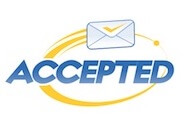|
Your Guide to Getting off the Waitlist in 2020-2021 |
||
Your Guide to Getting off the Waitlist in 2020-2021


The application process is not over for waitlisted applicants. You’ve still got a chance of getting into your dream school. Now’s not the time to slack off, and it’s certainly not the time to give up. Continue fighting for that acceptance!
Landing on a waitlist can be a nerve-wracking experience. As a result, sometimes waitlisted applicants let their anxiety or disappointment get the better of them. Many adcom members complain of applicants who react emotionally and behave in ways that are demanding, rude, disrespectful or otherwise inappropriate, either in their emails, calls, or even unscheduled drop-in visits to their offices. There may be 200 or more waitlisted applicants at your school, and these types of responses do not demonstrate perseverance; they reveal immaturity and lack of judgment. This behavior is duly noted and will work against you.
If you are waitlisted, take heart: the school is still very interested in you. You’re still a contender. To maximize your chances of turning your waitlist status into an acceptance, follow the school’s instructions precisely: Send what they ask for, and don’t send what they don’t want.
Your waitlist updates or letter of continued interest (you write those) and letters of support (other people write these) should focus on three areas: your growing list of qualifications, the steps you’ve taken to ameliorate shortcomings, and the ways in which you are the perfect fit for the school.
Your step-by-step guide to writing a waitlist update
Update letters should be short – no more than two pages. Keep the letter focused on what you have accomplished since applying. Here’s what you need to do to create a waitlist letter that will get you OFF the waitlist:
- Begin your letter by briefly thanking the school for considering your application.
Reiterate your commitment to the school and your belief that its philosophy and approach fit your educational preferences and goals. - Update your qualifications.
Choose achievements that you did not address in your application and try and tie them back to key themes in your essays. These could include a recent promotion, freshly minted A’s, a new leadership role in a project or organization, a recent volunteer experience, initiatives you’ve taken in your department, business, or club, or additional work responsibilities, etc. What is new and improved since you submitted your application? Ideally, you should relate these new achievements to some of the themes or experiences you addressed in your essays. - Talk about the measures you’ve taken to ameliorate your weaknesses or shortcomings.
Reinforce the idea that you are working to strengthen a weak spot in your profile. Focus on the specific actions you’ve taken rather than on the actual shortcoming. For example, if you have or have had weak communication skills, discuss how you enrolled in Toastmasters and how the experience influenced and inspired you. Examine, identify, and address weaknesses in your education, career, and community life.Also, if you have plans for additional classes or work but they have not yet taken place, get specific: report when and where you plan to take them, and state your willingness to enroll in any additional courses or follow any additional instructions that the school recommends or provides.
4. Emphasize your fit with the school.
If you are sure that upon acceptance you would attend, inform the school of your commitment. The message you want to get across is this: You were born to attend this school and this school was created just for you. Your fit is as perfect as a cozy glove on a cold hand.
How can you show the school you’re a perfect fit for their program? Prove it by explaining what else you have done to further your knowledge of their program and build your network there. You may already have mentioned in your application or in an interview how the school’s philosophy and approach match your educational preferences and goals, so in a waitlist letter, cite new examples that illustrate this match. For example, if you have visited the campus (post-submission), mention which class you sat in on, who taught it, and what your impressions were.
Similarly, mention recent email exchanges with alumni or students. What new aspect of the program that jives with your interests have you discovered through these connections? Investing in connecting with the school, its students, and resources will help drive home the message that this school is the best place for someone with your post-MBA goals.
MBA admissions directors want waitlisted applicants to show passion, but not obsession. Follow these steps, and you can be sure that schools will respond to this extra personal effort, provided that your sincerity is matched by an equal measure of professionalism and courtesy.
Waitlisters: 2 additional points to consider
A few things to look out for when creating your waitlist update:
- Before you start writing, be sure that your target school is open to receiving waitlist letters. If the school states explicitly that it doesn’t want to hear from you, then do not contact them – doing so will only hurt your case.
Watch: One med school admissions dean talks about how her team views letters of intent. >>
- When you’re at the brainstorming stage of the letter, and then again once you’re done writing, check and then double check that you haven’t repeated material already in your application – you don’t want to waste anyone’s time!
You are so close! Where do you go from here?
Accepted’s admissions experts are ready to help you get off the waitlist and into the school of your dreams. We’ll help you identify areas you can highlight in your waitlist letter, assist with strategy, and help you edit your letter so that you can be sure it makes the best possible case for your admission. Check out our waitlist services and contact us to get started.
 For 25 years, Accepted has helped applicants gain acceptance to top undergraduate and graduate programs. Our expert team of admissions consultants features former admissions directors, PhDs, and professional writers who have advised clients to acceptance at top programs worldwide including Harvard, Stanford, Yale, Princeton, Penn, Columbia, Oxford, Cambridge, INSEAD, MIT, Caltech, UC Berkeley, and Northwestern.
For 25 years, Accepted has helped applicants gain acceptance to top undergraduate and graduate programs. Our expert team of admissions consultants features former admissions directors, PhDs, and professional writers who have advised clients to acceptance at top programs worldwide including Harvard, Stanford, Yale, Princeton, Penn, Columbia, Oxford, Cambridge, INSEAD, MIT, Caltech, UC Berkeley, and Northwestern.
Want an admissions expert to help you get Accepted? Click here to get in touch!
Related Resources:
- Fitting In & Standing Out: The Paradox at the Heart of Admissions, a free guide
- Waitlisted? How to Turn Your “Maybe” into a “Yes”
- Life on a PhD Waitlist: Is There Anything You Can Do?
The post Your Guide to Getting off the Waitlist in 2020-2021 appeared first on Accepted Admissions Blog.

[0] Comments to this Article